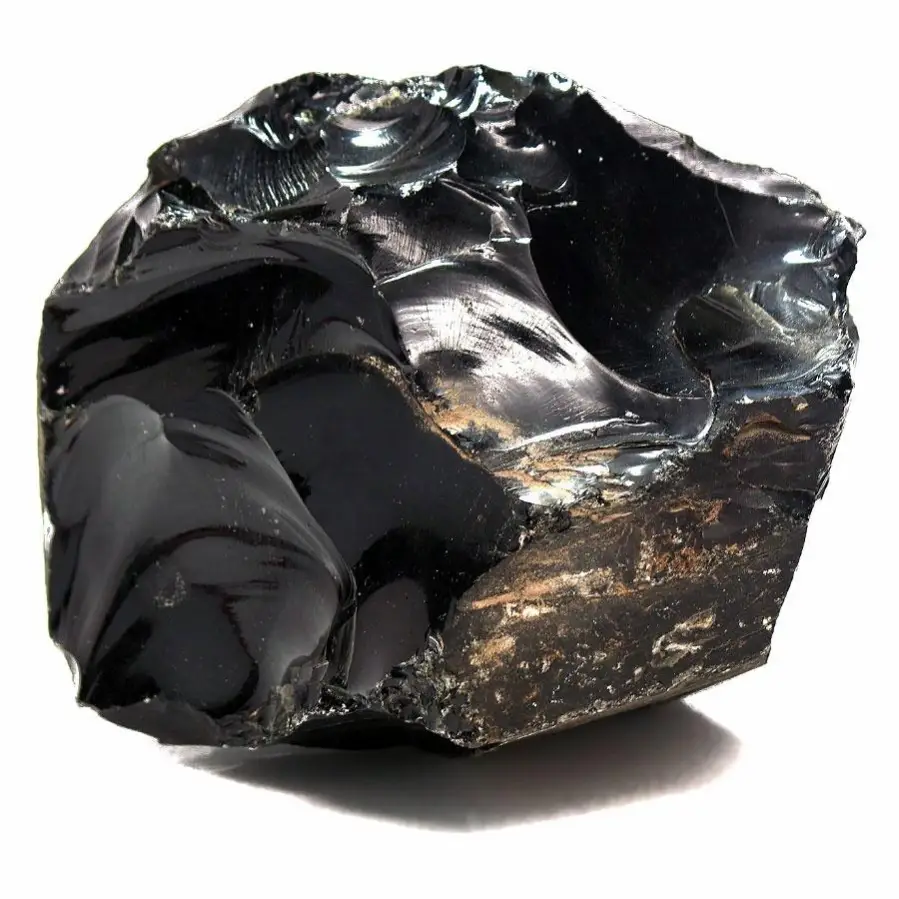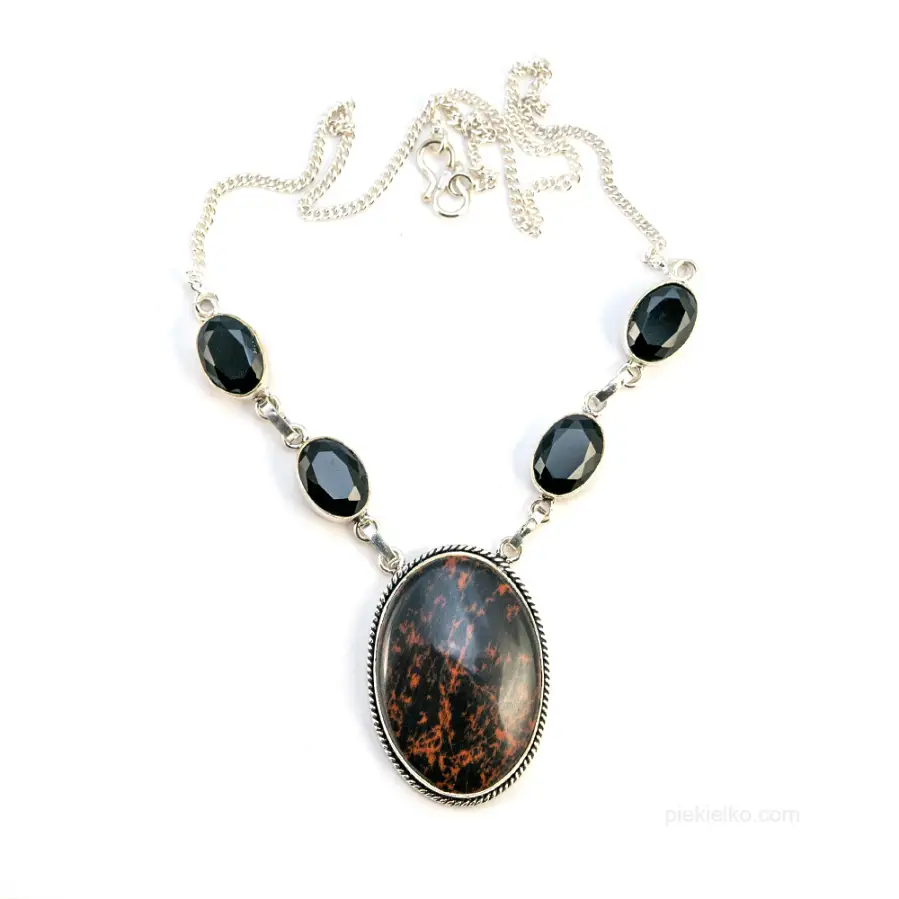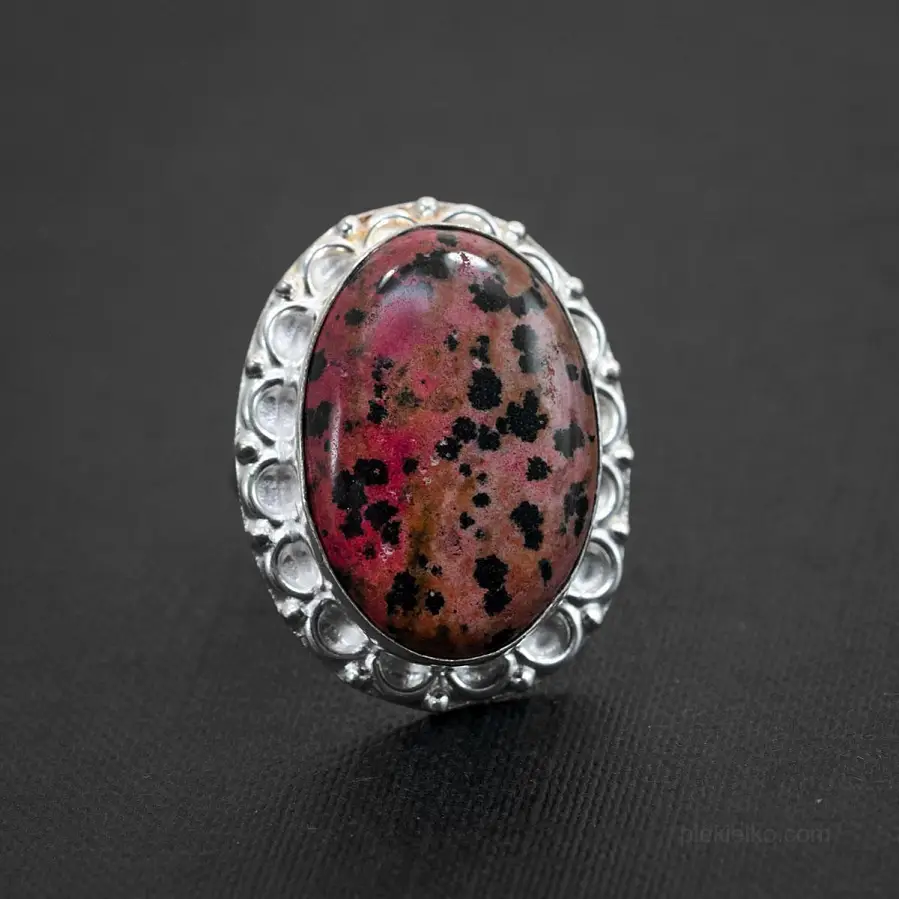Intermediates
Gallantry and accessories
Blog Piekiełka
Obsidian - black stone against fears

The history of obsidian dates back several thousand years. Obsidian was once used to make sharp tools and weapons. Like flint, it is ideal for this purpose due to its ease of processing. By grinding, very sharp edges are obtained, ideal for cutting and slicing. Later in antiquity, the mineral was also used to make artistic figurines, jewelry and mirrors. Native Americans to this day value obsidian as a healing and ornamental stone. Obsidian's former mainly utilitarian uses - tools and weapons - have today been replaced by the making of ornaments and jewelry.
One of the oldest written references to obsidian is by the Roman scholar Pliny (23-79 AD). In his work "De naturalis historia" he describes a black, glassy stone with partial transparency: "quem in Aethiopia invenit Obsidius, nigerrimi coloris, aliquando et translucidi", which means roughly: "which Obsidius found in Aethiopia, of a very black color, sometimes also translucent." In this way, Pliny indicated at the same time the godfather of the mineral, namely a Roman named Obsidus, who brought the stone from Ethiopia.
Properties of obsidian
Obsidian is an acidic mineral, composed almost exclusively of volcanic glaze, which is formed by the immediate cooling of lava. The rock-forming mass in this case does not crystallize, but forms a solid, glassy structure. This gemstone is mostly black, but can also contain admixtures that form other colors, as well as inclusions of feldspar and quartz.
The structure of obsidian is compact and amorphous, that is, it does not have the ordering inherent in crystals. For this reason, German mineralogist Dietrich Ludwig Karsten (1768 - 1810) once called obsidian "lava glass." However, this amorphous stone changes its structure over time, first forming radial crystals - spherulites, which resemble white snowflakes (snow obsidian).
The progressive crystallization of obsidian, and thus the aging of the stone, can be recognized by the aforementioned spherulites, which take the form of white, irregular flecks, visible on the surface of the obsidian.
The sheen of obsidian is glassy, and the hardness on the Mohs scale is 5 to 5.5, placing obsidian in the range of medium-hard minerals. The gemstone's fracture is shell-shaped and very sharp-edged. The density of the mineral is 2.33 to 2.43 g/cm3. Higher transparency occurs at the edges of the stone.
The formation of obsidian is always associated with volcanoes. For this reason, volcanic glass is found in volcanic areas both on the earth's surface and under the sea floor. Numerous obsidian mining sites have been discovered in Turkey, Indonesia, Japan, the USA, New Zealand, Greece and Russia, among others.
Color of obsidian
The color of obsidian is primarily black, with mineralogist Joseph Zappe describing it in detail as follows: "usually velvety black, sometimes partly grayish black, ash gray to clove brown." In addition, obsidian is also sometimes dark green, dark brown, golden brown, silvery gray or in reddish tones. Flemish botanist, chemist and mineralogist Anselmus de Boodt (1550 - 1623) compares obsidian in his work "Gemmarum et Lapidum" to black marble.
- The dark color of obsidian is caused by minerals such as hematite and magnetite, which can be found in it. The scratch, which is the color of the mineral scratching the porcelain plate, is white to light yellow in obsidian.
- In addition to the black volcanic glass form, there are various varieties of obsidian that have additional properties:
- Rainbow obsidian - this iridescent stone brings joy and love into life. It is called the stone of joie de vivre because it supports a sense of inner contentment.
- Snow obsidian - white flecks in the black mass of the stone give a special effect, it comes in different color varieties.
- Obsidian "Apache tears" - black with brown, purple or green, stone pure or smoky. This mineral has shell-like patterns, and was formed, according to legend, from the tears of Indians mourning their warriors killed in battle against white invaders.
- Gold obsidian - a golden glow in a black stone, caused by tiny gas bubbles. Its energy helps regain inner balance.
- Silver obsidian - this stone shines silvery, shows iridescence and transmits its energy to the interior.
- Mahogany obsidian - a combination of red brown and black transmits power, stimulates the soul and body, tensions and blockages disappear more easily.
- Blue-green obsidian - combines the properties of blue and green obsidian, supports the transmission of energy and creates an optimal balance between the soul and body.
- Steel-blue obsidian - a black stone with an iridescent glow, enhances intuition and the ability to perceive
The meaning and use of obsidian
Due to the compactness of the stone and the sharp edges of the break of the machined obsidian, it has been used since ancient times for making cutting tools and weapons. Today, the black stone is mainly used by artists to create small works of art and by jewelers to make jewelry.
Various facet cuts are used when working obsidian into jewelry ornaments. The black opaque mineral, with its snowflake pattern, is primarily given a smooth cut - cabochon oval or round, drop-shaped or slightly angular.
Although there are no clinical studies to date to confirm its healing properties, obsidian is a popular stone for physical and spiritual health.
Obsidian's effects on the human psyche
Black obsidian is considered to be the deepest mirror of the soul, bringing into consciousness everything that has been repressed into the subconscious. These can include fears and traumatic experiences, but also creative abilities. When using the properties of obsidian in these areas, one should be prepared to process negative experiences and embrace change. The manifestations of obsidian's effect on the psyche are:
- alleviating states of anxiety, trauma, shock;
- bringing out what has been repressed into the subconscious;
- supporting perception and spiritual abilities;
- bringing inner peace and clarity of mind;
- strengthening energy, removing blockages, protecting against evil energy.
Effects of obsidian on the human body
On the physical level, obsidian as a healing stone develops its warming effect. If someone with low blood pressure constantly complains, for example, of cold feet and hands, volcanic glass can be his excellent companion. Obsidian also helps with back pain, improves blood circulation, helps heal wounds and relieves muscle inflammation. A pendant with polished snow obsidian is said to help with a hangover after an alcoholic party.
Obsidian and zodiac signs
The black stone is an important birthstone for Scorpio and Sagittarius. For Scorpio, it helps to change outdated structures, while for Sagittarius it protects against negative energy and helps to achieve one's own goals.
Obsidian is also an important support stone for the zodiac signs of Capricorn and Libra. For Capricorn it adds determination and stability, and for Libra it helps understand unfulfilled desires and resolve their blockages.



© Piekielko.com



